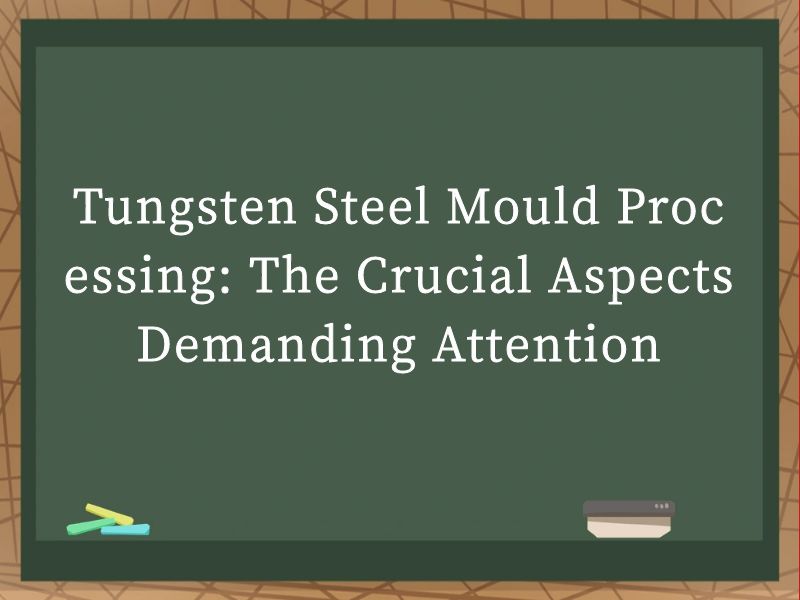JOURNALISM
- NEWS -
|
|
Tungsten Steel Mould Processing: The Crucial Aspects Demanding AttentionTungsten Steel Mould Processing: The Crucial Aspects Demanding Attention.Tungsten steel, also known for its hardness and wear resistance, is a material of choice for manufacturing moulds in various industries. The precision and durability of tungsten steel moulds are paramount to ensuring the quality and efficiency of the final products. However, processing tungsten steel moulds is not a trivial task. It requires meticulous attention to detail, a profound understanding of the material's properties, and adherence to best practices throughout the manufacturing process. This article delves into the critical aspects that deserve undivided focus during tungsten steel mould processing.
Understanding Tungsten Steel Properties Before embarking on the processing of tungsten steel moulds, it is essential to grasp the fundamental properties of this material. Tungsten steel, or tungsten carbide, boasts exceptional hardness, making it highly resistant to wear and tear. This hardness, however, comes with a trade-off in toughness, meaning that tungsten steel is prone to brittleness and can be challenging to machine. Its high density also contributes to its machinability challenges, as it generates significant cutting forces and heat during processing. Moreover, tungsten steel's thermal properties are critical. It exhibits low thermal conductivity, causing heat to accumulate in the cutting zone during machining. This heat build-up can lead to thermal deformation, tool wear, and surface damage on the mould. Therefore, effective temperature management is imperative throughout the processing stages. Selection of Machining Tools and Techniques The choice of machining tools and techniques is pivotal in tungsten steel mould processing. Due to the material's hardness, conventional tools and methods often fall short. Specialty carbide or ceramic cutting tools are typically used, as they can withstand the high wear rates and temperatures generated during tungsten steel machining. Diamond and cubic boron nitride (CBN) tools are also viable options, known for their superior hardness and wear resistance. These tools, however, come with higher costs and may require specific handling and storage conditions to maintain their performance. In terms of machining techniques, a combination of milling, drilling, grinding, and electrical discharge machining (EDM) is often employed. Milling and drilling operations are used for rough shaping and hole creation, while grinding is crucial for achieving the final surface finish and dimensional accuracy. EDM is particularly useful for intricate shapes and hard-to-reach areas, as it does not rely on mechanical cutting forces. Process Planning and Optimization Process planning is the cornerstone of successful tungsten steel mould processing. It involves the strategic selection of machining sequences, tool paths, and parameters to minimize tool wear, maximize material removal rates, and ensure dimensional accuracy. 1. Machining Sequences and Tool Paths The machining sequence should be designed to progressively remove material from larger to smaller volumes, minimizing stress concentrations and the risk of crack formation. Tool paths should be smooth and continuous, avoiding sharp changes in direction that could lead to tool breakage or excessive heat generation. 2. Tool Parameters Optimal cutting parameters, such as spindle speed, feed rate, and depth of cut, must be carefully selected based on the tool material, mould geometry, and desired surface finish. Higher spindle speeds generally reduce tool wear and heat generation but may require lower feed rates to maintain stability. 3. Coolant Application Effective coolant application is essential for managing temperatures during tungsten steel machining. Coolants not only reduce friction and wear but also help dissipate heat, preventing thermal deformation and surface damage. The choice of coolant type and delivery method (flood, mist, or high-pressure spray) should be tailored to the specific machining operation and tool used. Surface Finish and Dimensional Accuracy Achieving the desired surface finish and dimensional accuracy is crucial for the functionality and lifespan of tungsten steel moulds. This requires a meticulous approach to grinding and polishing operations. 1. Grinding Techniques Grinding is often the final stage of tungsten steel mould processing, responsible for achieving the specified surface roughness and geometric tolerances. The choice of grinding wheel (type, grit size, and bond) is critical, as it directly impacts the grinding efficiency and surface quality. To minimize surface damage and achieve a uniform finish, it is essential to maintain a constant grinding force and avoid overheating. This may involve the use of dresser tools to periodically dress the grinding wheel, removing glazing and maintaining sharp cutting edges. 2. Polishing and Finishing Polishing operations are used to further refine the surface finish, removing any residual grinding marks and achieving a smooth, reflective surface. Various polishing techniques, such as manual polishing, vibratory polishing, and drag finishing, can be employed depending on the desired level of finish and the complexity of the mould geometry. Inspection and Quality Control Quality control is an ongoing process throughout tungsten steel mould processing, ensuring that each stage meets the required specifications and standards. Inspection techniques play a vital role in this regard, providing feedback on the current state of the mould and allowing for corrective actions if necessary. 1. Dimensional Inspection Dimensional inspection involves measuring the mould's critical dimensions to verify compliance with design specifications. This can be achieved using various tools, such as micrometers, calipers, and coordinate measuring machines (CMMs). Regular inspections during processing help identify and correct deviations early, preventing costly rework. 2. Surface Inspection Surface inspection techniques, such as visual inspection, optical microscopy, and scanning electron microscopy (SEM), are used to evaluate the surface finish, texture, and the presence of defects. These inspections ensure that the surface meets the required roughness and integrity standards, critical for mould performance and product quality. 3. Material Integrity Testing Material integrity testing, such as ultrasonic testing and magnetic particle inspection, is used to detect internal flaws and cracks that may have formed during processing. These tests provide a comprehensive assessment of the mould's structural integrity, ensuring its reliability and safety in use. Post-Processing Considerations Once the tungsten steel mould has been processed and inspected, several post-processing considerations come into play to ensure its readiness for use. 1. Heat Treatment Heat treatment processes, such as quenching and tempering, can enhance the mould's hardness, toughness, and wear resistance. These treatments must be carefully controlled to avoid introducing stresses or altering the mould's dimensions. 2. Coating and Surface Modification Surface coatings, such as titanium nitride (TiN) or chromium nitride (CrN), can further improve the mould's wear resistance and reduce friction during use. These coatings can be applied using various techniques, such as physical vapor deposition (PVD) or chemical vapor deposition (CVD). 3. Storage and Handling Proper storage and handling practices are essential to maintain the mould's integrity and performance over time. This includes storing the mould in a dry, rust-free environment, avoiding mechanical impacts, and regularly inspecting for signs of wear or damage. Tungsten steel mould processing is a complex and demanding task that requires a deep understanding of the material's properties, meticulous planning, and adherence to best practices throughout the manufacturing process. By focusing on tool selection, process optimization, surface finish and dimensional accuracy, inspection and quality control, and post-processing considerations, manufacturers can ensure the production of high-quality, durable tungsten steel moulds that meet the rigorous demands of modern manufacturing. This attention to detail not only enhances the functionality and lifespan of the moulds but also contributes to the overall efficiency and profitability of the manufacturing operation. |


